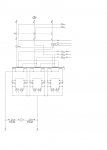Let's break this into bite size steps.
Draw a triangle, label the points A, B and C.
A to B is phase one,
B to C is phase two,
C to A is Phase three.
Three phases. This is what is distributed all over the country.
Now if you connect a transformer that goes from A to B, that is a single phase transformer, right? Because if it was 2 phase, it would have to be connected A-B and B-C, but not C-A.*
So if a transformer connected from A to B is single phase, and you bring the wires of the secondary down to your house, what yo you have at the house? You still have single phase, right? You haven't added any phases have you? You have not made any primary connection to C phase right? So with no connection to C, you can have no B-C phase or C-A phase, right? You only have A-B; one phase out of three.
Now if you take the secondary winding of that transformer and put a center tap in it, then ground that center tap as a neutral, you have "split" that phase into two parts right? In other words half of the voltage from A to N, the other half from B to N. Got that?
So how does putting in the center tap change the fact that the main part of that circuit is still just the one phase you started with, from A to B? Did adding that center tap make a connection to C phase? No.
Now just substitute A for L1 and B for L2. They are not Phase One and Phase Two, they are just opposite ends of the SAME phase. The residential voltage is a SINGLE phase of a three phase system that is center tapped to provide two levels of voltage; from Line to Line (L1 to L2) you have 240V, from either Line to Neutral you have 120V. Still the same SINGLE phase you started with though.
*(For those who know otherwise, let's not get this discussion clogged up by discussing true 2 phase systems yet OK? It just confuses people who have a hard time with this concept)



